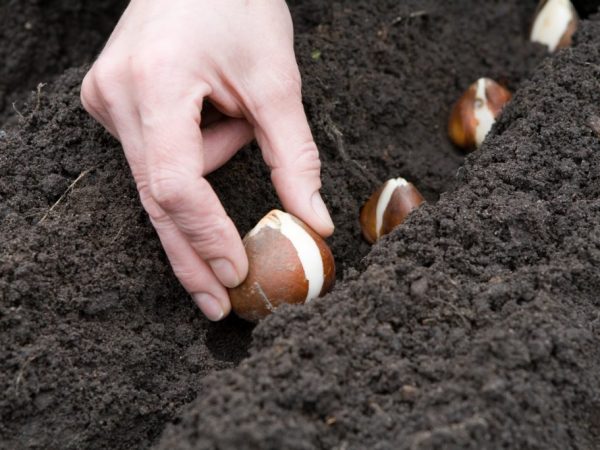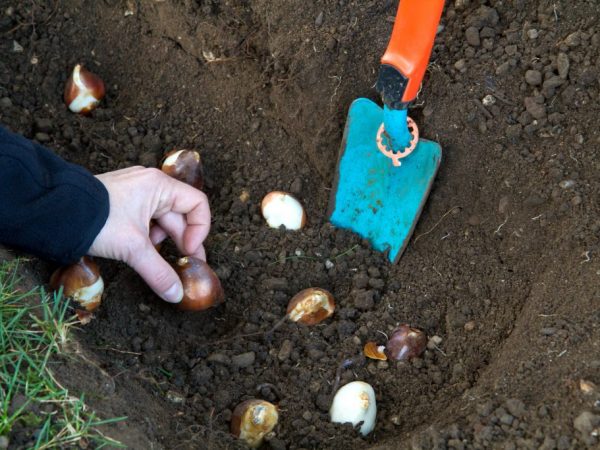Dates of planting tulips in Siberia
The climate in Siberia is not quite suitable for the cultivation of an orchard and vegetable garden. To get a harvest, you must strictly adhere to the rules for planting and caring for plants. Planting tulips in autumn in Siberia guarantees their timely and lush bloom in spring.

Dates of planting tulips in Siberia
Tulip planting time
Siberia is considered a zone of risky farming, therefore, to obtain the results of your labor, you should strictly follow the rules for planting and caring for plants.
Tulip bulbs take root for a little more than a month, so the timing must be chosen carefully. Bulbous plants should have time to grow a good root system before freezing in the morning.
Gardeners should keep a close eye on weather changes. They begin to plant tulips in autumn in Siberia when the temperature reaches zero at night. Usually in this area, such a moment falls on the second decade of September.
The timing of garden work is short enough and you need to manage to plant the seeds during this time.
Landing place
Particular attention is paid to the choice of a landing site. For growing tulips, an area protected from the wind is suitable, which receives a lot of sun. With a lack of light, the buds are poorly formed, they will be small and ugly, the flowers will soon wither.
The soil must be moisture-absorbing. For aeration, wood ash and sand are added to the ground before planting. Bulbs that receive a sufficient amount of the necessary substances during the growth period develop a powerful root system that contributes to the appearance of large flowers.
If the soil is loose and contains an impressive amount of sand, it needs to be fed and watered regularly. Too viscous soil does not allow oxygen to flow to the roots of flowers, and they begin to rot. It is recommended to loosen such soil regularly.
Preparing the bulbs
For the successful planting of tulips in Siberia, it is also necessary to observe the correct storage conditions for the bulbs. The quality of future flowers depends on this. It is necessary to store the planting material in such a way that it does not dry out, rot or be nibbled by mice.
In the room where the bulbs are stored, the following parameters must be monitored:
- The temperature should not exceed 20 °. Before planting in the ground, the temperature must be lowered to 15 °.
- Humidity. Excessive dampness in the storage increases the risk of fungus and bacterial infections in the planting material.
- Proper ventilation.
Experienced gardeners recommend wrapping the bulbs in a newspaper - this will save the planting material.
It is necessary to process the seeds before planting. This procedure improves survival and prevents diseases and pests. For this, you can use both special preparations and folk remedies.
Before planting bulbs in open ground, the following measures should be taken:
- Analysis of planting material. The bulbs are carefully sorted out, discarding the damaged and diseased specimens.The quality of the seed is determined by the density and uniform color, without spots and unevenness.
- Sorted by size.
- Hulling. Tough scales are removed, under which foci of infection can be hidden.
- Disinfection. It is carried out using a pale solution of potassium permanganate, into which the bulbs are dipped for half an hour.
Varieties for planting

It is necessary to choose frost-resistant varieties
Floriculture requires special attention, as it is necessary to select plants that can adapt to harsh weather conditions and produce healthy offspring. Tulips, which tolerate Siberian frosts well and delight with their flowering with the onset of the first warm days, would be an excellent choice.
With proper planting and care, almost all varieties will delight you with fast germination and beautiful flowers.
But the best results when growing tulips in Siberia are obtained when using the following varieties:
- Parade, Dover, Diplomat - hybrids;
- Dante, Carlton, Bonanza - terry early;
- Diana, Brilliant Star, General de Vet are common.
Almost all of these tulips bloom early. They should be planted in open ground in the fall, until frost occurs. Medium to large bulbs are preferred.
Planting
Plants should be planted in pre-prepared soil. 7-10 days before planting, the bed is dug to the depth of the base of the shovel. Planting depth is of great importance in the harsh climatic conditions of Western Siberia.
If the bulbs are planted shallow, they will simply freeze out in winter. Too much deepening leads to the fact that the plants do not emerge in due time, since they do not have enough strength to break through. The deep fit also prevents babies from tying.
The bulbs should be planted in furrows dug about 15 cm apart. A layer of sand about 4 cm is poured at the bottom of the pits. The bulbs are placed at a distance of 7 to 10 cm. It is recommended to plant planting material of different diameters mixed. Moreover, even with the death of some specimens, abundant flowering is achieved. So that the roots of the bulbs do not break off, it is recommended to plant them carefully, without pressing hard into the ground.
Sprinkle the seeds with manure or humus on top. The topsoil is carefully leveled. When planting in dry weather, the beds must be moistened. In winter, the beds should be covered with branches, straw or peat.
Care
When leaving, special attention should be paid to fertilizing the plantings. Excessive organic matter when grown outdoors will adversely affect flowering. Peduncles are bent, and the buds and flowers themselves acquire an irregular shape. This applies to all varieties of tulips.
The use of fresh manure as fertilizer leads to decay of the root system. Growth and development are positively influenced by green manure plants, which are plowed into the ground before planting the bulbs.
When to dig
The complex climatic conditions of the region force gardeners to dig up bulbous plants from the ground at the end of each season. If flowers are left for the winter, they may die. In surviving plants, the buds become smaller, and the plantings thicken.
Tulips should be dug out on time - it comes immediately after they have faded, and more than half of the leaves have fallen off. It is preferable to do this in dry, sunny weather. Flowers are allowed to be planted in the same place only after 3-4 years.
Conclusion
Planting tulips in Siberia in the fall requires careful observance of all the rules. Only in this case can you enjoy the abundant flowering of the plant afterwards and get healthy material for further reproduction.

